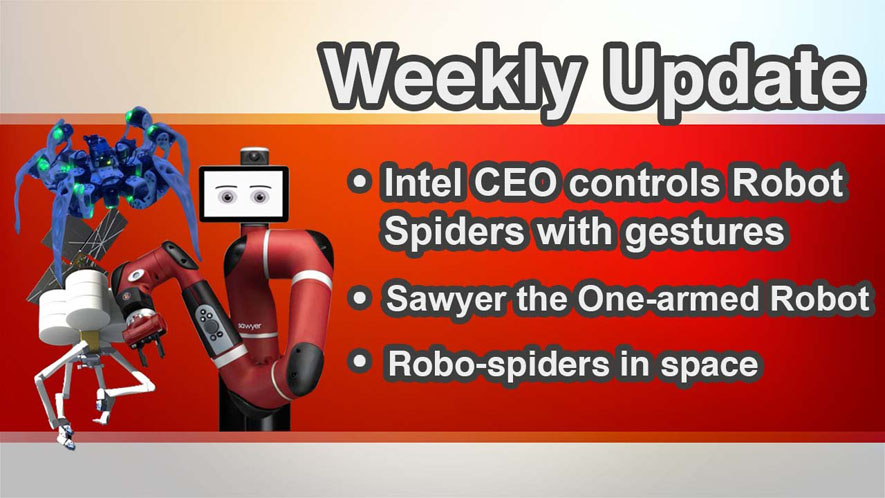Hi there, and welcome to my weekly Robot Update. This is wear I do a round up of what is going on in the Robot news around the world, so stay tuned.
Hi Guys, I’m Philip English from robophil.com, and welcome to the Robot Weekly update number 17.
Intel CEO controls a swarm of robot spiders with gestures
Forget the Apple Watch. Forget the Pebble Time. What you really need is a wristband that gives you the power to control an army of scary-looking drones.
At IDF in Shenzhen, Intel CEO Brian Krzanich put on a simple Curie-powered wristband with motion detection, which then let him commandeer four robot spiders.
With some simple gestures, Krzanich was able to make them stand up, change the LED colors on the drones, make them do “fist” pumps and eventually go back to idling.
The CEO was showing off the company’s new Curie chip, which despite being smaller than a penny, has all the tech needed to detect gestures and then send the gesture commands to Krzanich’s new robotic minions.
When it comes to gesture control, there is no one as enthusiastic as the chip maker. Intel has been a supporter of gesture control along with 3D scanning, and the company has introduced its RealSense technology into select desktops, laptops, tablets and drones.
Sawyer the one-armed robot
Sawyer the one-armed robot can do many things, such as assemble goods on the factory floor day after day without tiring or taking toilet breaks.
It was three years ago that we first heard about Rethink Robotics’ Baxter industrial robot.
Priced at US$22,000 and requiring no programming expertise on the part of its users, it was intended to bring robotic automation to manufacturers who would otherwise not be able to afford it.
Now, Rethink has announced the more compact and agile Sawyer robot.
Like Baxter, Sawyer runs on Rethink Robotics’ Intera software system. Among other things, this allows it to learn tasks by having a human trainer physically guide its articulated arm through a specific activity.
It can then build on what it’s learned, adapting its behaviour to complete the same task while compensating for changing variables.
Also like Baxter, it has built-in safety features that allow it work side-by-side with humans, instead of being sectioned off in a cage. If its arm should accidentally come into contact with a person, for instance, it will automatically stop whatever it’s doing.
The actual 19-kg (42-lb) robot itself has the same animated expressive eyes as Baxter, intended to make it a little easier for its non-robotic co-workers to relate to. It also utilizes a vision system that consists of a wide-angle video camera in its head, along with a camera and light source in its wrist for getting close-up views of intricate tasks.
Its arm has a reach of just over one meter (3.3 ft), seven degrees of freedom, and can lift up to 4 kg (8.8 lb). Each of the joints on that arm contain high-resolution force sensors, which let it “feel” its way into tight spaces without wrecking anything.
According to the company, “This enables an adaptive precision that is unique to the robotics industry and allows Sawyer to work effectively in semi-structured environments.”
Robo-spiders in space
Spiders on mars may have been predicted by david bowie, but in fact spiders in space could help us get to the red planet.
Tether unlimited has revealed a system of robo spiders than can construct solar panels, trusses and other parts of spacecraft in orbit.
The nasa-back firm says it could dramatically reduce the cost of building spacecraft by allowing the final construction to take place in orbit.
The futuristic new system – dubbed SpiderFab – is being developed by a company called Tethers Unlimited.
The system uses arachnid-like robots to construct large objects in orbit around the Earth or further into the Solar System.
‘This process will enable space systems to be launched in a compact and durable ’embryonic’ state,’ the firm says.
Once on orbit, these systems will use techniques evolved from emerging additive manufacturing and automated assembly technologies to fabricate and integrate components such as antennas, shrouds, booms, concentrators, and optics.
‘The primary benefit of this on-orbit fabrication capability will be order- of-magnitude improvements in packing efficiency and system mass, which will enable NASA to use small, low-cost launch vehicles to deploy systems
dramatically larger than possible with current state-of-the-art technologies.
The net payoff will be to enable NASA to acquire and distribute a variety of forms of data at higher resolution, higher bandwidth, higher signal-to-noise, and lower life-cycle cost.’
Our really long-term objective for all of this work is to eventually enable the use of in-situ resources to construct the infrastructure in space needed to support humanity’s expansion throughout the solar system,’ Dr. Robert Hoyt claimed last month during a presentation with NASA’s Future In-Space Operations (FISO)
working group.
That’s it guys, for a weekly world Robot News, I am your host Philip English
If you like this weekly report and want to see more of the latest Robot News, Reviews and robotic tutorials, then please hit the subscribe button, to keep up to date.
I have put further information about the robots in the weekly robot update in the links below, as well as extra webs link for your review.
If you have a robot product that you would like me to do a review or do a tutorials for, then please ping me over a message in the comments section and I will see what I can do.
Thanks Guys! I looking forward to see you next time.
INTEL Robots | Rethink Sawyer | Robot Space Spiders Weekly Update YouTube: https://youtu.be/ETcA3he4qU0
Philip English: https://philipenglish.com
Sponsor: Robot Center: http://www.robotcenter.co.uk

